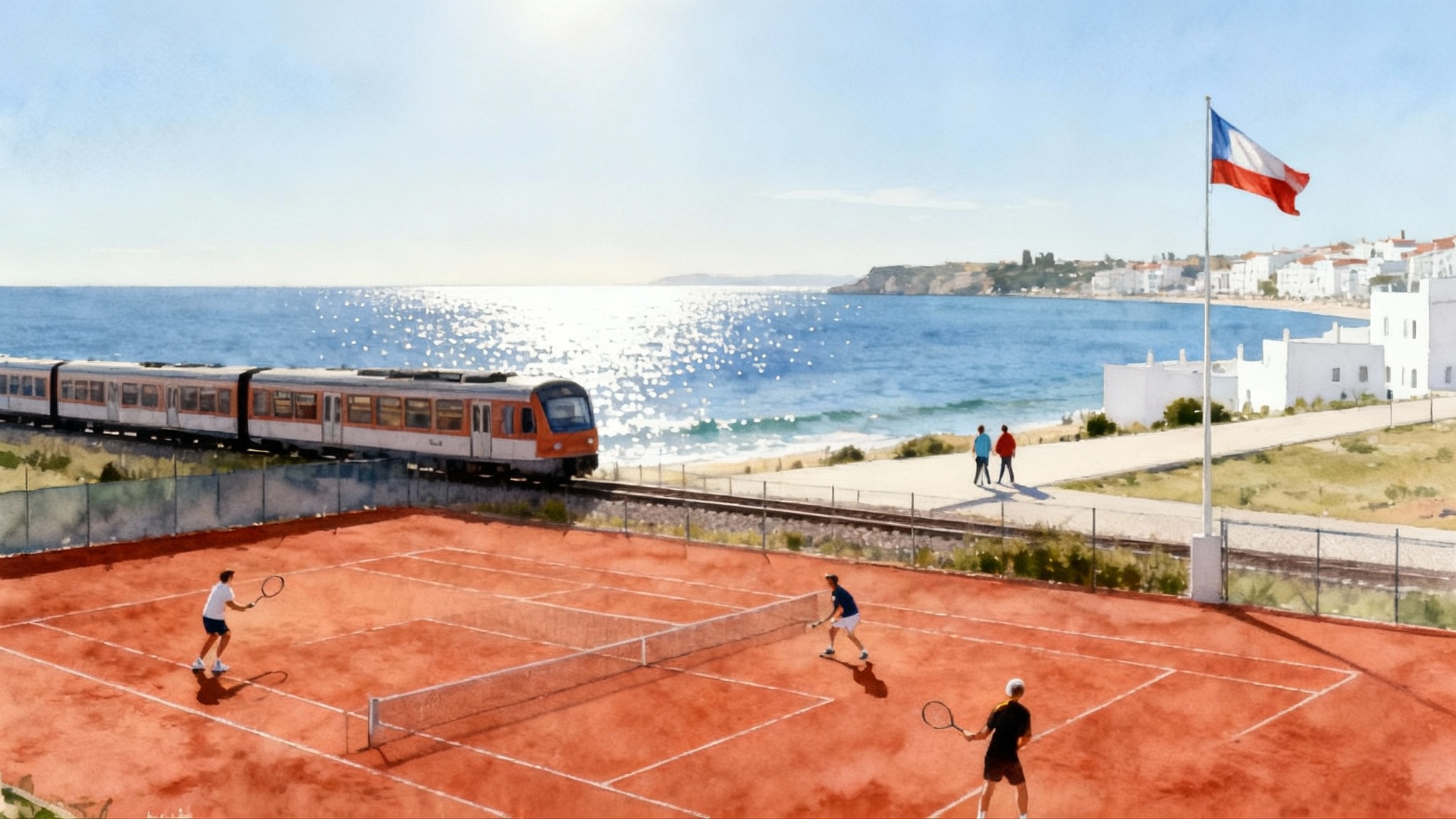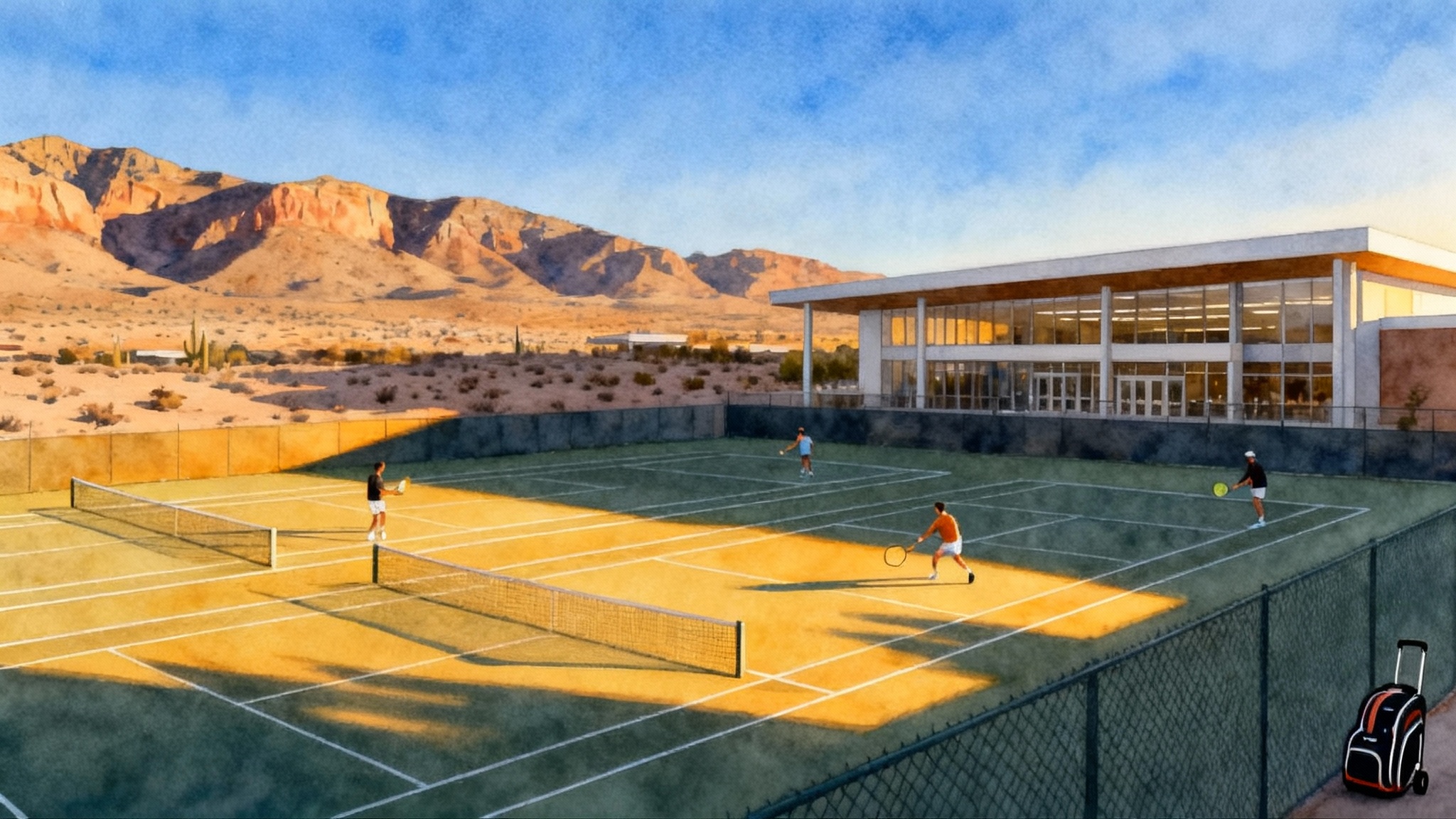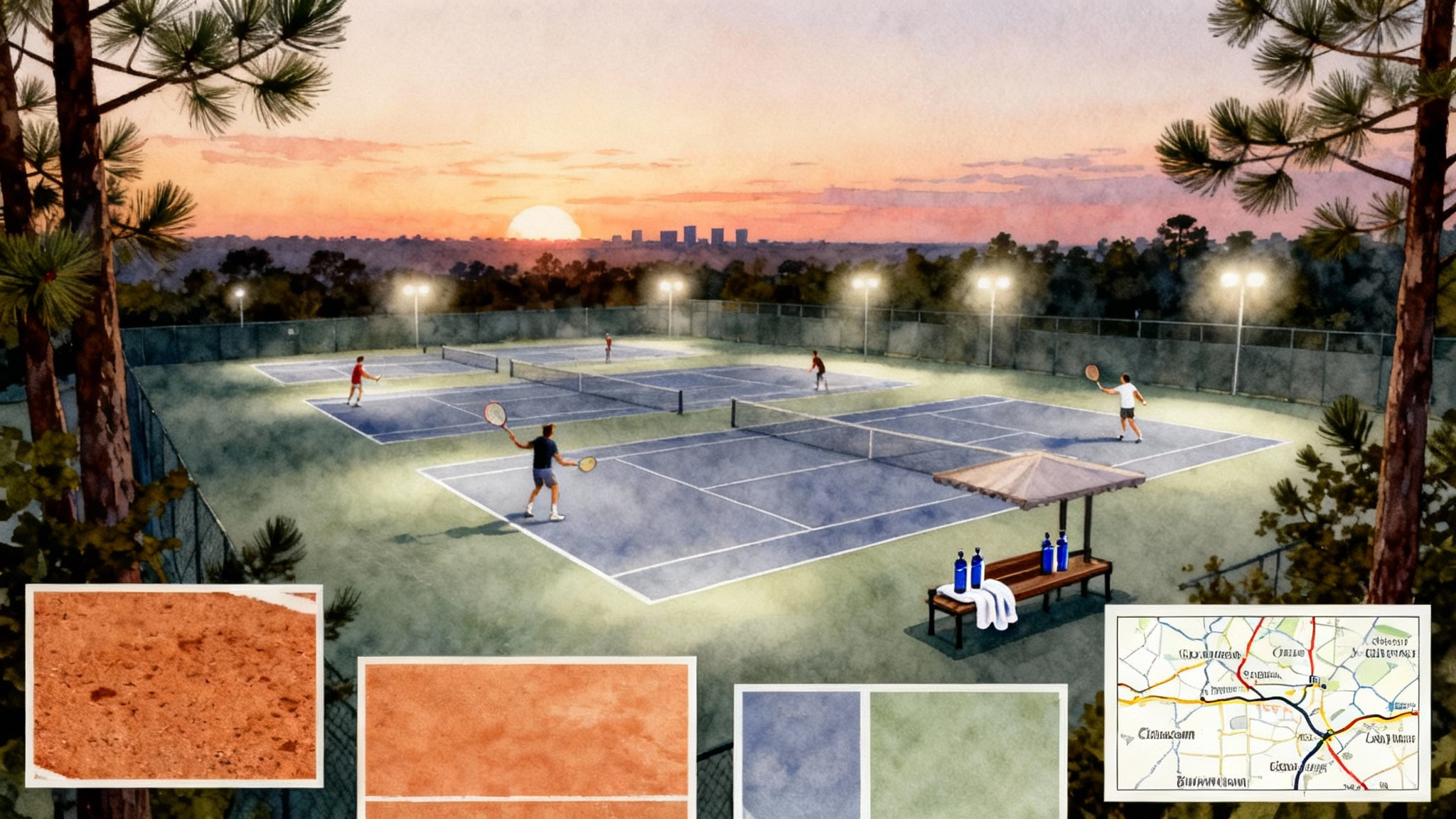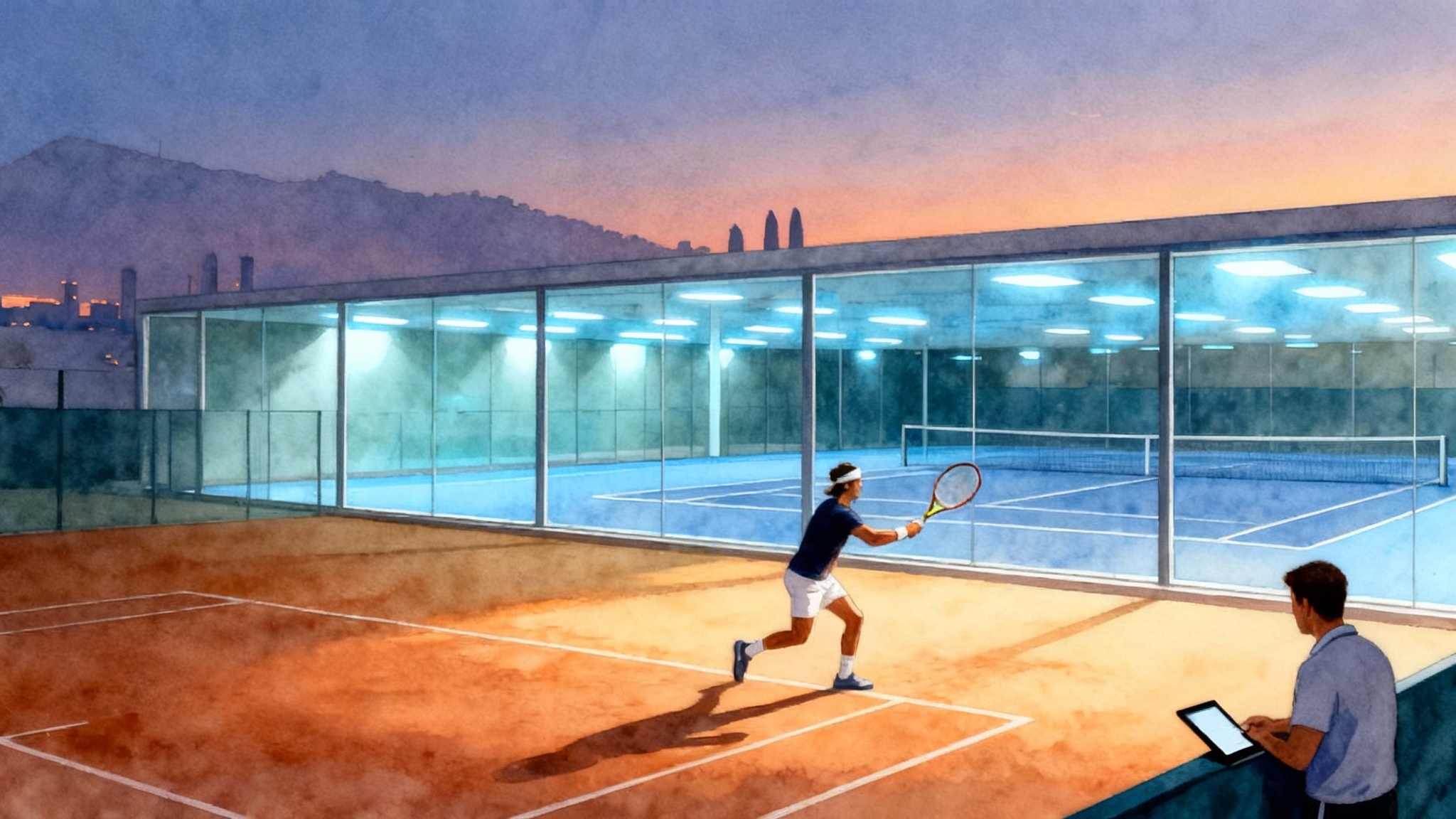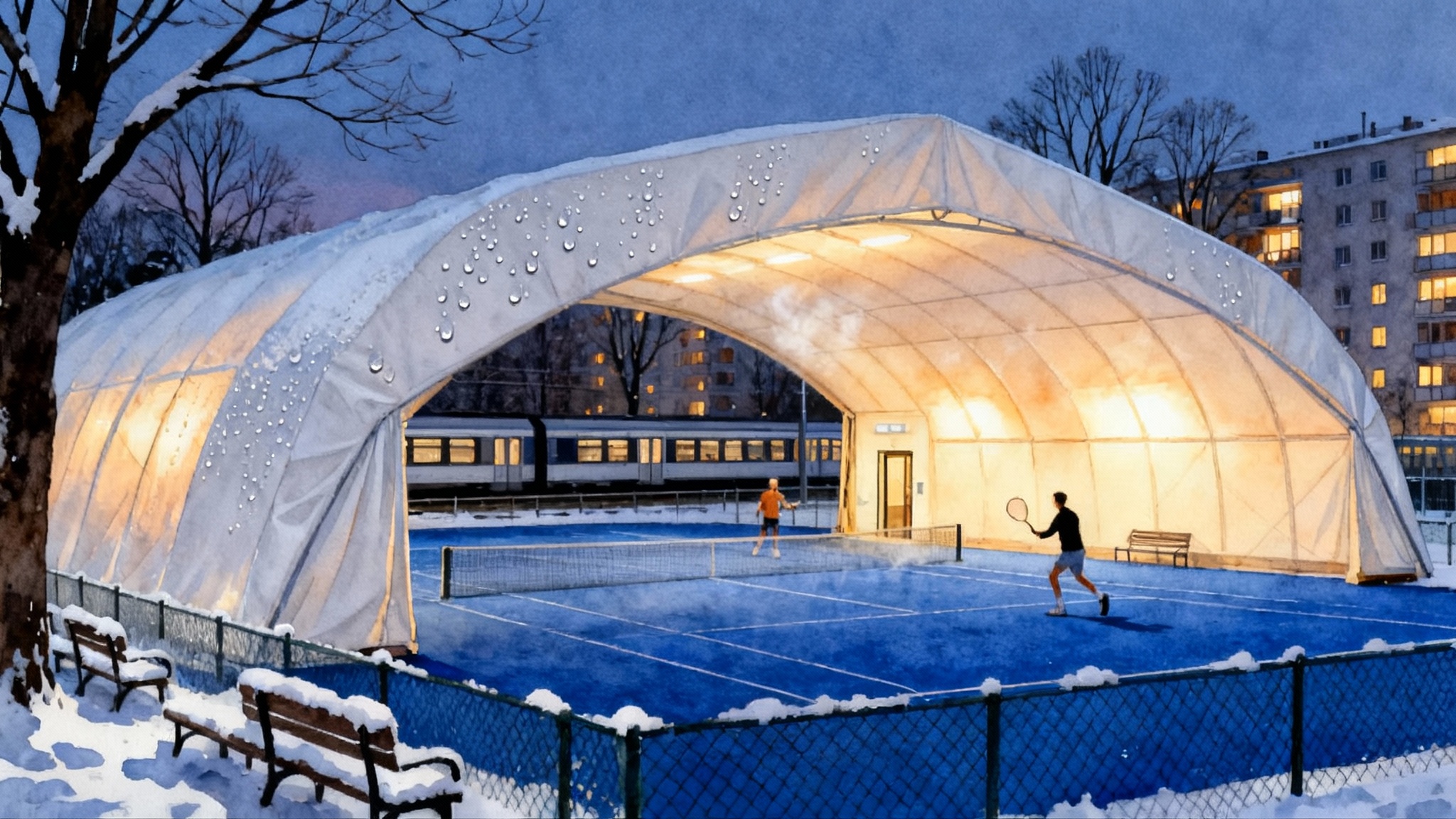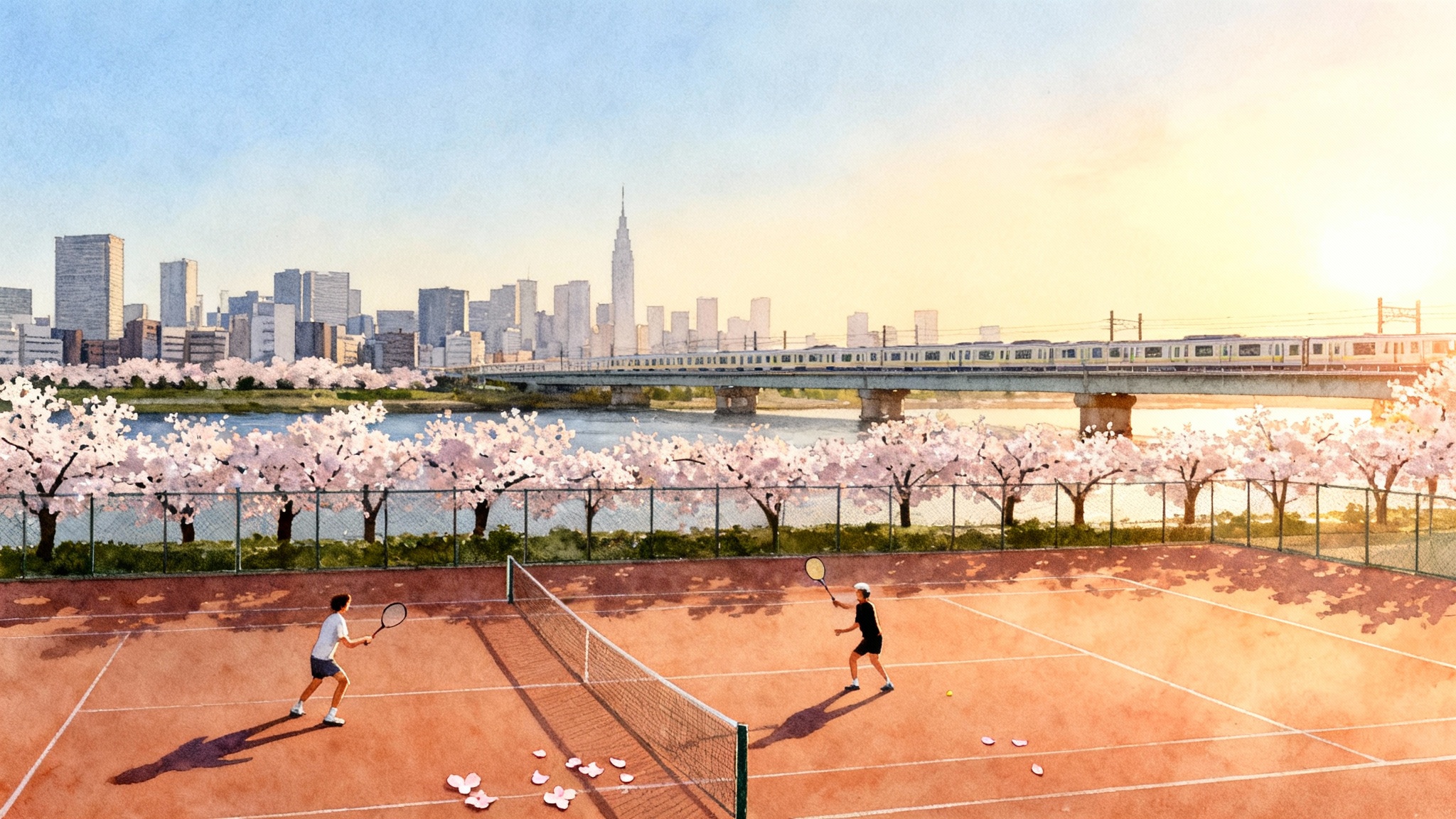Indian Wells-Palm Desert Winter Tennis Guide 2025-26
Plan your 2025–26 winter and spring tennis block in the Coachella Valley. Learn why November to April brings near-guaranteed court time, how to mix public complexes with resort clinics, and how to pair training with the BNP Paribas Open.
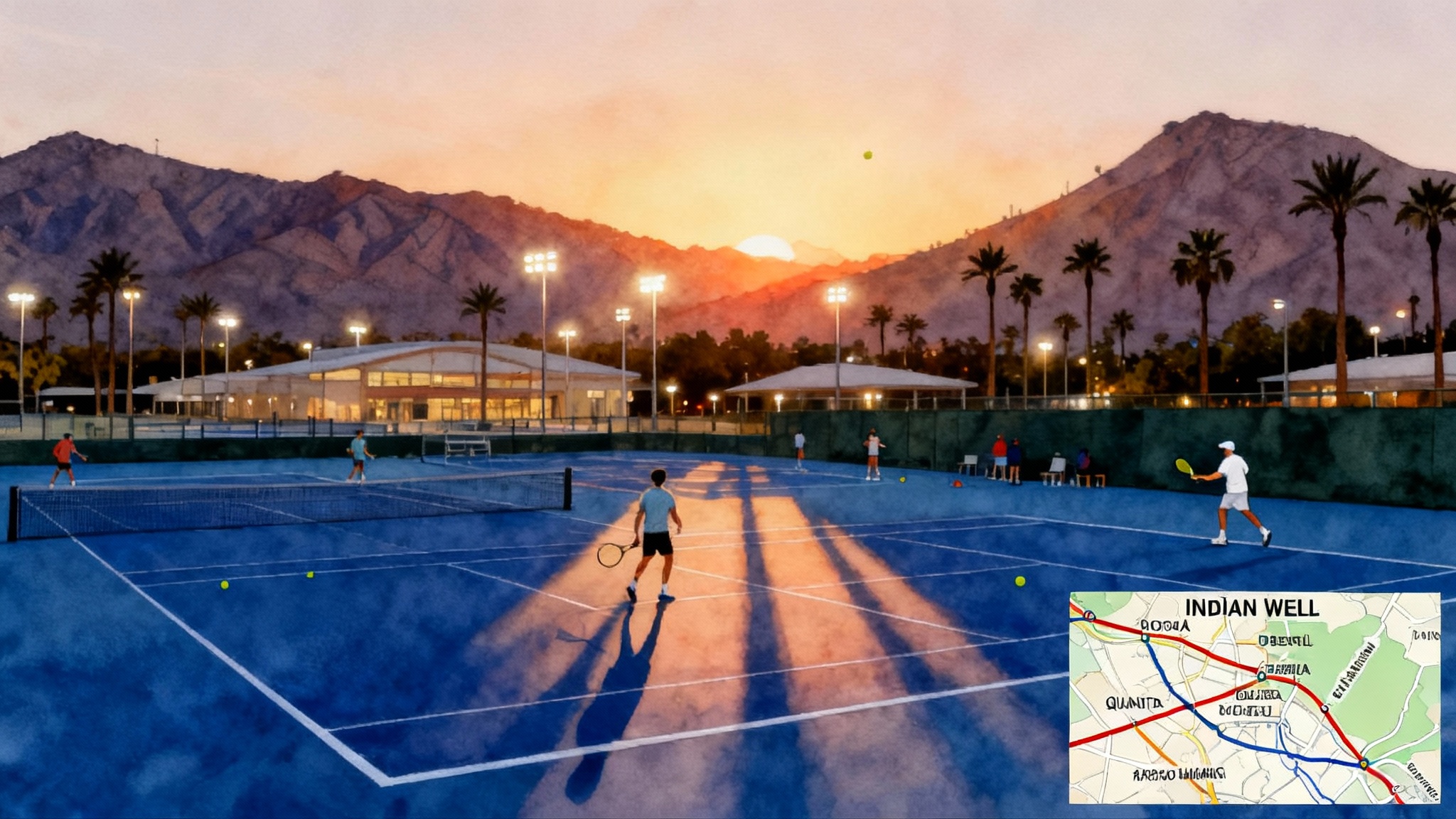
Why the Coachella Valley is America’s dry-season tennis base
If you want reliable outdoor court time between November and April, the Coachella Valley is hard to beat. Indian Wells, Palm Desert, La Quinta, and Rancho Mirage sit in a rain shadow that keeps winter skies clear, humidity low, and courts dry. Even when a Pacific system drifts through, the surfaces tend to dry quickly, so a light shower costs hours rather than days. Mornings start crisp, afternoons warm into short-sleeve weather, and the sun lingers late enough for twilight sets after work hours. In short, it is tennis weather on repeat.
A seasonal rhythm helps you plan. November and December bring cool mornings that reward early-bird hitters. January and February are temperate and consistent, ideal for volume. March adds more daylight and the energy of the region’s signature event, the BNP Paribas Open, which fills the valley with players and fans. April warms toward summer, but mornings remain prime for quality reps. For a humid, year-round U.S. option, compare with the Atlanta year-round base guide.
Desert conditions bring two performance benefits. First, low humidity makes long rallies feel less taxing, which helps you sustain high-tempo drilling across multi-day blocks. Second, consistently dry courts remove the guesswork from scheduling. You can build a progression week with confidence that your on-court dose will happen.
There are tradeoffs to manage. UV is intense, so sunscreen and scheduled shade breaks matter. Afternoon winds can pick up, especially in spring; handle it by moving key technical work to morning sessions and using windy afternoons for competitive sets and serve targets. Nights can cool quickly, so pack a light layer for evening match play.
Anchor your week around the Indian Wells Tennis Garden
The Indian Wells Tennis Garden is the gravitational center of tennis in the valley. Every March the site hosts the BNP Paribas Open, one of the sport’s most attended events, with qualifying, day and night sessions, and elite practice viewing. For dates, tickets, and on-site maps, use the official BNP Paribas Open information.
Outside the tournament window and on non-event days, the Garden offers public court time, clinics, and a pro shop. Book ahead, especially in peak months, and budget for higher rates than municipal courts. For current offerings and reservations, check the Indian Wells Tennis Garden programs and courts. If your home base is a club network, a Life Time Tennis membership can complement your desert block with year-round access elsewhere.
Public complexes for everyday volume
You can build the backbone of your week on city-run complexes across Palm Desert, Palm Springs, Rancho Mirage, and La Quinta. These centers typically offer multiple hard courts, lighting for evening play, and straightforward reservation systems through municipal recreation portals. Rates are friendly, and many post drop-in doubles or round-robin slots.
How to use them well:
- Reserve morning blocks between 7:00 and 10:00 when winds are calmer and the light is soft.
- If your group is flexible, book twilight slots after 4:00 to dodge mid-afternoon sun and reduce fees.
- For ball machine work, call ahead; some complexes maintain machines you can reserve.
- Ask about weekly ladders or rating-based mixers that connect you with local hitters.
Resort clinics for coaching eyes and new patterns
Several resorts run daily clinics open to non-guests for a fee. The formats range from live-ball point play to stroke-tune sessions, often capped at 4 to 6 players per court. Call the pro shops early in the week to map the schedule and request a level-appropriate court. A smart rhythm is three public-court sessions for volume and two resort clinics for input and pattern variety.
Booking play at the Garden without wasting time
- Look at the Garden’s calendar to avoid blackouts for private events.
- Reserve at least a week out in February and March. Same-week spots exist, but the best times go fast.
- Bring a copy of your reservation on your phone for quick check-in. The complex is large; arrive 15 minutes early to find your court.
- If you are prepping for match play, ask the desk which court clusters are most wind-sheltered on that day.
Two practical itineraries
Below are training blocks you can copy, then tune to your level. Ranges assume a 3.0 to 5.0 player. Coaches can expand the hitting time by 15 to 30 percent for advanced groups.
A 5-day accelerator (Monday to Friday)
Goal: sharpen timing, raise rally tolerance, and exit with match confidence.
Day 1
- Morning: 90 minutes of cross-court forehand and backhand tempo, plus 30 minutes serve plus first ball. Finish with 20 minutes of volley-first exchange.
- Afternoon: 60 minutes of point play to tiebreak. Use one new tactic only, such as early cross to open line.
- Recovery: 15-minute walk and calf raises. Hydrate to colorless urine before dinner.
Day 2
- Morning: 60 minutes pattern drilling. Alternate deuce-side inside-out forehand sequences and ad-side backhand line holds. Add 20 minutes serve targets and 20 minutes return plus two balls.
- Evening: 90-minute doubles clinic at a resort to layer in new patterns and pace.
Day 3
- Morning: 120-minute match play. Two fast four sets with different partners. Track first-serve percentage and return depth.
- Midday: Off-court mobility and 15 minutes elastic band work for shoulders.
Day 4
- Morning: 90 minutes live-ball with constraints. Examples: first strike must land in the inner third; approach only off deep balls; no slice for 15 minutes.
- Afternoon: 60 minutes serves and returns under scoreboard pressure. Play race to eleven with a serve target.
Day 5
- Morning: 90-minute test set. Play a full set with changeover routines. Between points, slow down and pre-commit to serve pattern.
- Afternoon: Optional 60-minute light hit or ball machine rhythm.
A 7-day pre-season block
Goal: accumulate reps without soft-tissue complaints, then capture gains in matches.
- Day 1: Arrival and 60-minute light hit. Focus on height and shape.
- Day 2: Two hours technique and footwork ladders. Finish with tiebreak ladder.
- Day 3: Two hours pattern work. Afternoon 45-minute serves. Evening mobility.
- Day 4: Match day. Two sets singles or one set singles plus one set doubles. Record serve percentage and unforced errors.
- Day 5: Regeneration. One hour cooperative drilling and 30 minutes pool movement. Optional hike on the Bump and Grind Trail for circulation.
- Day 6: Two hours high-pace live-ball. Afternoon 30-minute returns and transition volleys.
- Day 7: Match day. Use your new first-serve pattern on all deuce points for one set and switch on ad points for the next set. Cool down and review notes.
A March plan that pairs training with the BNP Paribas Open
In March the valley fills with fans, college teams, and touring pros. That can enhance your week if you plan early.
Three-day long weekend
- Friday morning: 90-minute drill block at a city complex. Midday stadium grounds pass for practice-court viewing. Night session inside the main stadium.
- Saturday morning: 60-minute maintenance hit. Afternoon day session. Take notes on two tactics you will test at night.
- Saturday night: 60-minute light hit to apply what you watched. Keep intensity low.
- Sunday morning: Match play set. Travel midday.
Five-day tournament immersion
- Day 1: Garden clinic in the morning. Afternoon grounds pass to locate practice courts and watch a player with your body type.
- Day 2: Early court booking for serves and returns. Day session inside the stadium. Night off.
- Day 3: Rest morning. Afternoon day session. Night 60-minute hit at a nearby complex.
- Day 4: Match play in the morning. Night session to see a top seed. Pay attention to serve plus one patterns.
- Day 5: Light hit and travel.
Ticketing and parking tips
- Buy sessions for early rounds if you want the most matches per dollar. Later rounds deliver star power but fewer matches.
- Arrive early for practice viewing and bring a hat and refillable bottle. You can step out between sessions to reset and rehydrate.
Where to stay and how to move
Lodging zones
- Walkable perimeter of the Garden: highest rates but lowest friction. Ideal if your purpose is maximal tournament time.
- Palm Desert central: good access to both public complexes and resorts, broad dining options, and shorter drives to La Quinta and Rancho Mirage.
- La Quinta neighborhoods near Washington Street: quiet rental homes, quick drives to the Garden, and easy access to resort clinics.
- Palm Springs proper: more nightlife and mid-century hotels. Plan on 25 to 40 minutes to the Garden depending on traffic.
Booking tactics
- For March, reserve lodging by early January to secure inventory close to the Garden.
- Check whether resort fees cover court access or just facility use. Court fees vary by time and demand.
- Ask for a unit on the ground floor or near parking if you carry a ball basket and portable hopper.
Getting around
- Rent a car if you plan multi-stop days that include a morning hit, an afternoon clinic, and evening match play.
- Parking at city complexes is simple and often free. At resorts, expect valet or self-park fees; factor that into your budget.
- For bike-friendly players, several neighborhoods around Palm Desert and Indian Wells make safe early-morning rides to courts.
Booking courts without stress
- Municipal portals: Create accounts before you travel. Load a payment method and store your preferred time windows.
- Pro shop calls: Call two to three days ahead for clinics and 24 hours ahead for private lessons. Confirm the court surface and ball brand used by the coach.
- Rain checks: While rare, ask about the facility’s policy. City complexes often allow easy reschedules; resorts may credit your account.
- Ball machine: Reserve separately. Bring your own balls for serving if you want consistent bounce.
Finding match play and practice partners
- TennisAcademy: Use the TennisAcademy match board to filter by rating, availability, and preferred side. Post your itinerary and let local players claim slots.
- City ladders: Ask front desks about weekly singles ladders or doubles mixers. Many centers maintain WhatsApp or email lists.
- Coaches and sparring: Pro shops often know reliable hitters who can tune the session intensity to your level. For a structured pathway, consider the Life Time Tennis Academy.
Conversation starters that work
- “Looking for a 4.0 doubles match Thursday 7:00 pm near Palm Desert. We have balls.”
- “Two lefties in town for three days, seeking high-tempo drilling partner, Wednesday morning.”
Desert vs Florida: costs and conditions
Weather reliability
- Rain-out risk: The Coachella Valley’s dry pattern yields fewer cancellations than Gulf Coast or Atlantic Florida. Even when it rains, hard courts return to play quickly because of the arid air.
- Humidity: Desert air makes long rallies feel more manageable and reduces hand-slip on grips. In Florida, sweat management becomes a bigger part of session design.
Budgets and access
- Courts: City courts in both regions are affordable. Resort courts in the desert often carry higher fees, especially during peak season and tournament weeks. Florida resort fees can be lower outside of Miami and Orlando but vary by property.
- Lodging: March in the desert is premium season. If cost is the priority and you are flexible on location, Florida beach towns and inland communities may offer more mid-range options during the same window.
- Airfare: West Coast travelers usually find the desert more convenient; East Coast travelers often see better fares into Florida hubs. Factor car rental differences; desert driving is simple and fuel costs are predictable.
Training quality
- Florida gives you humidity conditioning that can pay off for summer leagues but risks more grip and shoe changes each session.
- The desert gives you predictability and ball speed. Your topspin shapes stay honest, and you can plan a 14-session week with minimal weather edits.
Pack smart for desert performance
- Hydration: Start each day with water plus electrolytes. The air is dry enough that thirst lags effort. Aim for a bottle before you start, one during, one after.
- Sun: Sunscreen with high zinc content, a brimmed hat, and a light long-sleeve for coaching or spectating.
- Wind plan: Two drills ready for breezy days. For example, lower net clearance targets and extra split steps on approach balls.
- Feet and hands: Two pairs of shoes in rotation, fresh overgrips daily, and a spare set of socks for the second session.
- Recovery: A small massage ball, elastic shoulder band, and a silicone cup for forearm release. The dry air speeds recovery if you supply fluids and soft-tissue care.
- Logistics: A soft cooler for courtside storage, a towel that can double as shade for grips, and a pencil notebook for quick notes between sets.
Sample daily notes template
- Today’s focus: one sentence.
- Serve pattern plan: deuce and ad court.
- Two cues for groundstrokes: simple and external, like “big hip turn” or “see seams.”
- Match stat to track: first-serve percentage, return depth beyond service line, or net point win rate.
- Recovery checklist: liters consumed, protein target, time to lights-out.
Common questions answered quickly
- Is November too cool for early mornings? It is crisp at dawn, then pleasant by mid-morning. Start at 8:00 rather than 7:00 if you prefer short sleeves.
- Can I guarantee a hitting partner? No, but between city ladders, resort clinics, and our match board, you can usually fill two sessions per day with compatible players.
- Do I need a coach every day? No. A good ratio is three self-led sessions to one coached session. Use coaching to check patterns, not micromanage every stroke.
- What about clay? A few facilities offer clay, but hard courts dominate. If you need a clay day, call around early and be flexible on times.
A final, smart way to build your week
Think like a tour team. Book the backbone first: morning public-court blocks for volume. Layer two resort clinics for coached pattern work. Add a match day in the middle and at the end. If your trip lands in March, stitch in sessions at the tournament so you can study patterns mid-week and apply them that night. The desert rewards planners with near-guaranteed court time, steady bounces, and the special spark that comes from training in the same valley where the pros compete. Build your block with intention and you will leave with confidence that travels home with you.
